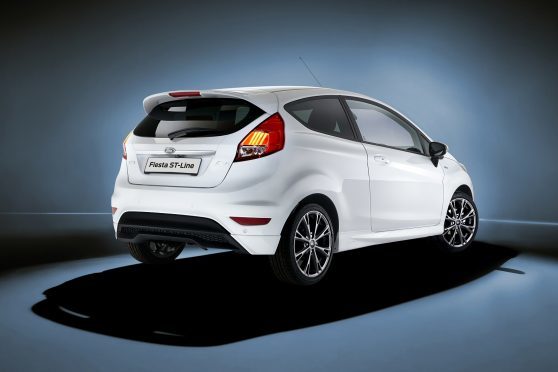Not everyone needs an ultimately powerful little hot hatch.
High insurance premiums and even higher asking prices can often put paid to shopping rocket dreams.
Which is why some makers will sell you a supermini with all the look and feel of a real GTi but none of the drawbacks.
Here’s Ford’s solution, the Fiesta ST-Line.
We’ve had plenty of really great sporting Ford Fiestas. In fact, the Blue Oval brand’s hot hatch legacy around this model goes all the way back to the XR2 of 1981, with a history subsequently embellished by the more powerful RS1800 and RS Turbo models that followed it.
Best of all was the hot hatch version we have now, the 1.6-litre Fiesta ST, launched in 2013.
Unfortunately, it costs around £18,000 – or an astounding £23,000 if you want the top ST200 version.
So what if you could have a sporty Fiesta that looks just the same for not much more than around £16,000?
That sounds more like it. It’s the recipe delivered by the Fiesta ST-Line.
Of course, going the ST-Line route isn’t going to get you the kind of power you’d enjoy in a fully fledged ST.
If that’s not an issue, then there’s plenty to like here.
Fiesta ST-Line buyers get a choice of four engines.
Three of them are variants of the brand’s three cylinder 1.0-litre EcoBoost petrol turbo unit, developing either 98, 123 or 138bhp.
If you really must, there’s also a 93bhp, 1.5-litre TDCi diesel variant too.
We’d go for the 98bhp petrol variant. Choose one of the other derivatives and you’re getting to the point where you might as well have shaken the piggy bank a little further and gone for a fully-fledged ST model. The 1.0-litre variant in contrast seems to give you everything you need without too much of what you don’t.
Rest to 62mph takes 11.2 seconds and working the little powerplant hard delivers a pleasant, buzzy thrum.
The 138bhp version gets to 62mph in 9.0 seconds on the way to 125mph.
Through the bends, the handling should be sharp, thanks to a 10mm lowered chassis and the well-weighted steering and short, crisp gearshift feel we’ve experienced in other Fiestas.
The fact that the suspension is a touch softer than that of the full-fat ST may actually be of benefit on bumpy roads, whereas this ST-Line variant is unlikely to crash through tarmac scars quite as much.
At first glance, this ST-Line Fiesta looks just like a normal ST model – at least in three-door form anyway. You can’t get an ST with five doors but that body style is available to ST-Line customers, another potential buying incentive.
ST-Line styling specifics include a honeycomb design for the trapezoidal front grille, fog lamps with dark surrounds and a front bumper lip spoiler. There’s also a rear diffuser element, a large rear roof spoiler, a black beltline beneath the windows, deep side-skirts, ST-Line exterior badging on the front wings and 17in alloy wheels finished in Rock Metallic Grey.
Inside, ST-Line buyers get sport seats with red stitching, a perforated leather ST-style steering wheel with grey stitching, an ST-style gear knob, a dark woven headliner and ST-Line scuff plates.
Otherwise, it’s the usual Fiesta recipe. Rear seat space in the three-door version is better than the claustrophobically rising beltline might lead you to expect. Once you’re in the back, the Fiesta surprises with headroom manageable even for a six-footer – though his or her legs will be pretty snug against the seat in front. There’s also a 276-litre boot.
Fiesta ST-Line prices start at around £15,800 for the 1.0-litre 98bhp model, so there’s a saving of around £2,000 over the 1.6-litre full-fat ST hot hatch model.
The whole point of choosing an ST-Line Fiesta rather than a sportier ST model is to reduce your costs. Which is broadly what’s delivered here.
A normal ST manages 47.9mpg on the combined cycle and 138g/km of CO2.
Go for the fastest ST-Line variant, the 1.0-litre EcoBoost 138bhp derivative featuring Start and Stop, and you can improve those figures to 62.8mpg and 104g/km. The 98 and 123bhp versions improve that showing further – to 65.7mpg and 99g/km. And in the 1.5 TDCi diesel variant, you can potentially manage up to 78.5mpg and 94g/km.
That only leaves depreciation. If you’re a prospective customer, then you’ll be glad to hear that Fiesta residual values are on the up as both new and used markets respond well to the increase in quality of the latest generation car. Expect to get around 50% of your initial purchase price back after three years – which is basically unheard of for a Fiesta.
Most commentators agree that the Fiesta ST is the hot hatch to have in the junior shopping rocket segment.
If you’ve decided that too, but concluded that the costs involved are just that little bit beyond you, then these ST-Line models offer a very tempting alternative.
Yes, there’s less power, but the handling promises to be very nearly as good – and possibly in some circumstances even better – than Ford’s established class leader.
Plus, there’s the advantage of being able to order the more practical five-door body style.
Go on, you know you want to.
THE FACTS
Model: Ford Fiesta ST-Line
Price: From around £15,800
Engine: 1.0-litre EcoBoost petrol developing 98bhp
Performance: 0-60mph in 11.2 seconds
Economy: 65.7mpg
CO2 emissions: 99g/km
